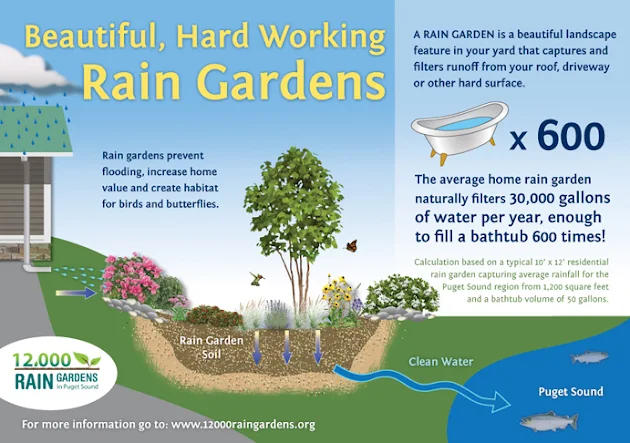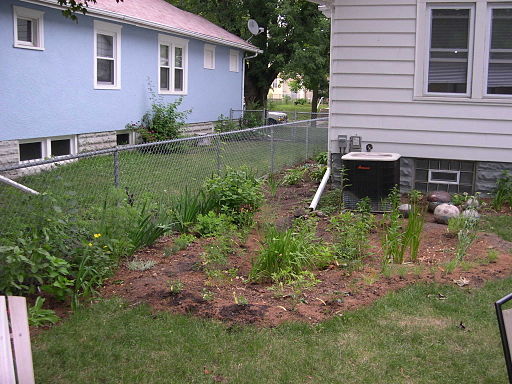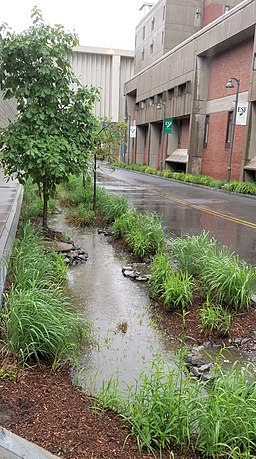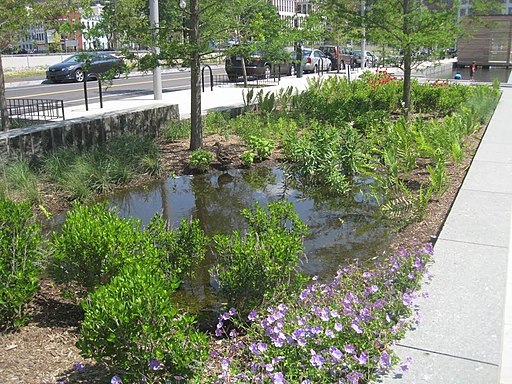What are Rain Gardens
Rain gardens are a relatively new concept in the history of landscaping and environmental management. The idea of rain gardens originated in the 1990s in Prince George's County, Maryland, in response to concerns about water pollution and stormwater runoff.
 |
| Hey look! A roadside rest-stop rain garden in Virginia! (the rain garden is behind the sign 😀) |
During heavy rainfall events, large amounts of water run off from impervious surfaces such as roads, driveways, and rooftops, carrying pollutants such as fertilizers, pesticides, and oil into nearby streams and rivers. This runoff can harm aquatic ecosystems and contaminate drinking water supplies.
To address this problem, the Maryland Department of Environment developed the concept of rain gardens as a way to capture and treat stormwater runoff at the source. Rain gardens are a shallow, depressed area of a yard or lot designed to capture, filter, and absorb stormwater runoff, allowing it to be absorbed into the ground and filtered naturally by soil and plants.
The first rain garden was installed in Prince George's County in 1990, and the concept quickly gained popularity across the United States and around the world. Today, rain gardens are used as a sustainable solution for managing stormwater runoff in urban and suburban environments, providing both environmental and aesthetic benefits.
Are Rain Gardens Related to Xeriscaping?
Rain gardens are often associated with xeriscaping, which is the practice of using plants that are well-suited to local conditions and require little or no watering beyond natural rainfall. While xeriscaping is often associated with dry regions, it can also be used in regions with abundant rainfall, like the Pacific Northwest, as a way to preserve water usage.
Rain gardens are an excellent complement to xeriscaping because they help capture and conserve water, reducing the need for irrigation. By using native plants that are well-suited to local conditions, rain gardens can also provide habitat for native wildlife and support local ecosystems. |
| Source: 12000raingardens.org |
Benefits of Rain Gardens
Mitigating Pollution Impact
One of the leading merits of installing a rain garden in your yard is the ability to combat pollution. These natural drainage systems capture stormwater runoff, filtering out harmful pollutants like oil and fertilizers before they contaminate local waterways. By acting as a barrier to pollution, rain gardens significantly improve the health of nearby rivers and streams.
Fostering Wildlife Habitats
Rain gardens are a haven for local wildlife. The native plants you choose to include in your garden not only add visual appeal but also serve as crucial habitats for pollinators, birds, and various other wildlife species.Flood Control Measures
Say goodbye to yard flooding and soil erosion. Rain gardens are expertly designed to capture excess rainwater, dramatically reducing the chances of flooding and soil erosion in your area.
Natural Water Filtration
By utilizing permeable soil and specially selected plants, rain gardens serve as organic filtration systems. They purify the rainwater that flows into them, contributing to improved water quality in local ecosystems.
Boosting Local Biodiversity
Rain gardens do more than just look pretty; they contribute to increased local biodiversity. Their ecological design supports various plant and animal species, creating a more vibrant and resilient local environment.
Cost-Effective Stormwater Management
Rain gardens help lessen the load on local sewer systems, mitigating the need for costly infrastructure enhancements. This long-term saving makes them a cost-effective option for homeowners concerned about sustainable living.
Aesthetic Enhancement
Elevate your landscape with a rain garden's natural beauty. They can be customized with an array of colorful, low-maintenance plants and flowers, enriching your property's visual appeal while offering multiple environmental benefits.
Water Conservation
For regions grappling with water scarcity or stringent water-use restrictions, rain gardens offer a solution by capturing rainwater for gradual ground absorption. This reduces the need for additional irrigation, conserving valuable water resources.
Step-By-Step Guide: How to Build a Rain Garden for Sustainable Living
Select the Ideal Location
To begin with, identify a low-lying spot in your yard that meets certain criteria for the perfect rain garden:
Optimal Sunlight: Aim for a spot that enjoys a minimum of 6 hours of sunlight daily, as many rain garden plants thrive in full sun or partial shade.
Soil Quality: Opt for an area with well-draining soil. Areas with heavy clay or poor drainage are not suitable for effective rain gardens.
Safe Distance: Ensure that the selected area is at least 10 feet away from your home's foundation, as well as from septic systems and wells, to avoid water damage.
Locations to Avoid for Rain Gardens:
Septic Vicinity: Stay clear of areas near septic tanks or other underground utilities to prevent damage or malfunction.
Natural Ponds: Avoid regions where water already tends to pool, as this can overwhelm the garden's stormwater management capacity.
Property Boundaries: Steer clear of installing your garden too close to property lines to dodge any neighborly disputes.
High-Traffic Zones: Don’t pick a place frequented by foot traffic, as this can compromise the plants and the garden's functional integrity.
Calculate the Garden Size
Estimate the size of your garden based on the roof area that drains into it. Generally, the rain garden should be around 20% of that size for optimal performance.
Dig the Rain Garden Basin
Create a shallow depression, about 6-8 inches deep, at your chosen location. Gradual slopes should guide water toward the garden's center.
Prepare the Soil Mix
Add a well-balanced soil mixture comprising sand, compost, and topsoil. Ensure you don't compact the soil too tightly, as this can affect water infiltration.
Select Native Plants
Opt for native plants that can withstand both drought and heavy rainfall conditions. Do thorough research on the plant varieties you choose to understand their mature size and optimal growing conditions.
Add Mulch
Finalize your garden by spreading a layer of mulch. This helps retain soil moisture and prevents weed growth.
Rain Garden Zones
Rain gardens are structured usually with 3-4 specialized zones that serve unique functions. Each zone is designed to accommodate plants with varying water needs and tolerance levels. Understanding these zones is critical for achieving a well-balanced and functional rain garden. Here's an optimized guide to these critical garden areas.
Zone 1: The Wet Zone - Where Water Thrives
The Wet Zone, the rain garden's lowest level, is engineered to absorb and retain maximum water. It's an ideal environment for water-loving plants like rushes, ferns, and sedges that can endure short spells of submersion. This zone often incorporates gravel or sand layers to boost water infiltration rates.
Ideal Plants for Zone 1: Wet Zone
- Cattails (Typha spp.)
- Marsh Marigold (Caltha palustris)
- Pickerelweed (Pontederia cordata)
- Blue Flag Iris (Iris versicolor)
Zone 2: The Moist Zone - Balance of Wet and Dry
Situated above the Wet Zone, the Moist Zone is programmed to retain water for extended periods. Native grasses, shrubs, and perennial plants that can adapt to both wet and dry soil conditions flourish here.
Perfect Plants for Zone 2: Moist Zone
- Black-eyed Susan (Rudbeckia hirta)
- Purple Coneflower (Echinacea purpurea)
- Bee Balm (Monarda spp.)
- New England Aster (Symphyotrichum novae-angliae)
Zone 3: The Transition Zone - From Wet to Dry
This zone acts as a buffer between the moist lower zones and the drier surrounding landscape. Plants chosen for this region are usually more drought-resistant and can include prairie grasses and wildflowers.
Zone 4: The Upland Zone - Echoing the Native Landscape
The Upland Zone mimics the native surroundings and generally hosts trees and shrubs acclimated to drier soil conditions.
Recommended Plants for Zones 3 & 4: Transition and Upland Zones
- Black Chokeberry (Aronia melanocarpa)
- Buttonbush (Cephalanthus occidentalis)
- Red Twig Dogwood (Cornus sericea)
- Winterberry (Ilex verticillata)



No comments:
Post a Comment